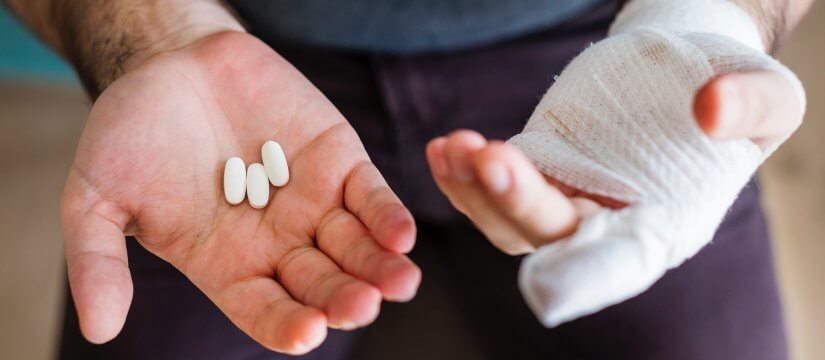
Francis* is a grandmother. From her nice slacks and sensible shoes to the small bobby pin that holds back the gentle curls around her face, she appears every bit the sweet, average grandmother you’d expect. But she is not. Francis is an addict.
Like many other patients we treat, Francis is addicted to opioids. She’s been through drug rehab – several times – and wishes more than anything that she could get off of them. The saddest part of this story, however, isn’t just the addiction. It is the truth that Francis is still in the very pain for which she started taking the opioids. She now deals with the double-whammy of her original pain and her addiction.
This poses the question: Could a therapy-first course of action have saved her from both?
The Relationship Between Addiction and Physical Therapy
 Addiction and physical therapy don’t seem to be related, but each path begins at the same point – the point where an injury occurs. Whether a patient is suffering from back pain, a muscle strain or a broken bone, the first thing a medical provider does is rule out major issues and determine if surgery is necessary.
Addiction and physical therapy don’t seem to be related, but each path begins at the same point – the point where an injury occurs. Whether a patient is suffering from back pain, a muscle strain or a broken bone, the first thing a medical provider does is rule out major issues and determine if surgery is necessary.
If the injury is musculoskeletal and no surgery is needed, two options typically follow: pain meds or physical therapy. The path chosen can have very different outcomes. What many people don’t know is that physical therapy can also be a patient’s first course of action.
According to a report from the American Physical Therapy Association (APTA), approximately 100 million American adults deal with chronic pain, and the treatment of that pain reaches a cost of nearly $600 billion annually. Let’s take a look at the two primary treatment scenarios individually.
Scenario 1: A patient sees a primary care physician for pain treatment after an injury and is first prescribed opioids for pain management. As is typical with opioids, the medication works well at first, but begins to lose efficacy over time, leaving the patient dealing with the original pain issue. More medication or alternative methods of pain management are required and the danger of a lingering opioid addiction exists.
Scenario 2: A patient seeks out the help of a physical therapist following an injury. As a natural, non-addictive therapy, the patient has the ability to improve function, strength and range of motion without the danger of possible addiction issues post-treatment. By getting to the source of the original pain, physical therapy addresses the impairments causing it, rather than masking the symptoms.
Do opioids have a role in addressing pain? Absolutely. Do all patients who take opioids become addicted? No. However, only one of the options above completely eliminates the introduction of opioids.
Is Physical Therapy More Effective Than Opioids For Pain?
While modern society tends to put a premium on quick-fix solutions, the rising opioid epidemic has both patients and experts advocating for safer alternatives. A whopping 79% of patients who have undergone surgery would choose a non-opioid option for treatment of pain over opioids. Aside from the fact that death by overdose of prescription opioids has quadrupled over the past 15 years, non-opioid treatments, like physical therapy, avoid many unwanted side effects.
 Opioids are known to cause addiction, increased sensitivity to pain, constipation, nausea, depression and lowered testosterone levels. Evidence also shows that the use of opioids can decrease a person’s response to naturally occurring rewards, like the release of endorphins during exercise.
Opioids are known to cause addiction, increased sensitivity to pain, constipation, nausea, depression and lowered testosterone levels. Evidence also shows that the use of opioids can decrease a person’s response to naturally occurring rewards, like the release of endorphins during exercise.
None of these are associated with physical therapy treatments. Even better, the APTA report indicates that non-opioid options are safer, more effective and longer lasting.
However, some patients argue that the use of opioids is necessary to mask or reduce pain, in order for them to get through other treatments, like physical therapy. The truth is quite the opposite: opioids are no better than non-opioids in improving pain-related function. Non-opioid patients even reported less pain intensity at the end of 12 months.
Physical Therapy Offers Better Quality of Life After Injury
Francis is no better off than she was the day she started taking opioids. Had she seen a physical therapist for her musculoskeletal pain prior to ever being offered pain meds, who knows what kind of life she would be leading? Because she is still in so much pain – or heavily medicated with some sort of pain-killer – she is unable to enjoy her family, friends, or the social activities that should be integral to her “golden years”. Instead her “golden years” are covered in darkness and sadness. Even with no degenerative or neurological disease, she is unable to do her own basic household chores.
There is no way to guarantee that Francis would be pain-free today, had she first sought the help of a physical therapist. But there is no doubt that her quality of life would have been much improved had she never taken that first opioid and become an addict.
As physical therapists, we have the ability to influence the mindset of our medical culture. Physical therapy could be the key to letting one more sweet grandmother enjoy her grandchildren, one more patient regain quality of life, and one less life get stolen by addiction.
Smart Body Physical Therapy’s Laura Bunso has served as an advocate for physical therapy for pain management, working to inform Florida legislature about the PT solution and emphasizing the need to reduce opioid reliance.
*Name has been changed to protect patient privacy.
